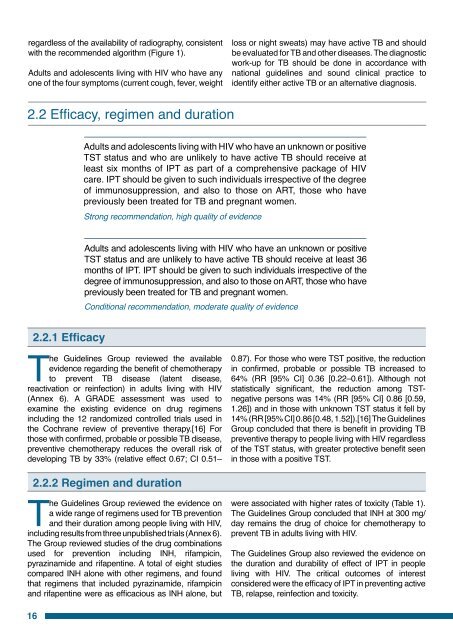Guidelines for intensified tuberculosis case-finding and isoniazid ...
Guidelines for intensified tuberculosis case-finding and isoniazid ...
Guidelines for intensified tuberculosis case-finding and isoniazid ...
You also want an ePaper? Increase the reach of your titles
YUMPU automatically turns print PDFs into web optimized ePapers that Google loves.
egardless of the availability of radiography, consistentwith the recommended algorithm (Figure 1).Adults <strong>and</strong> adolescents living with HIV who have anyone of the four symptoms (current cough, fever, weightloss or night sweats) may have active TB <strong>and</strong> shouldbe evaluated <strong>for</strong> TB <strong>and</strong> other diseases. The diagnosticwork-up <strong>for</strong> TB should be done in accordance withnational guidelines <strong>and</strong> sound clinical practice toidentify either active TB or an alternative diagnosis.2.2 Efficacy, regimen <strong>and</strong> durationAdults <strong>and</strong> adolescents living with HIV who have an unknown or positiveTST status <strong>and</strong> who are unlikely to have active TB should receive atleast six months of IPT as part of a comprehensive package of HIVcare. IPT should be given to such individuals irrespective of the degreeof immunosuppression, <strong>and</strong> also to those on ART, those who havepreviously been treated <strong>for</strong> TB <strong>and</strong> pregnant women.Strong recommendation, high quality of evidenceAdults <strong>and</strong> adolescents living with HIV who have an unknown or positiveTST status <strong>and</strong> are unlikely to have active TB should receive at least 36months of IPT. IPT should be given to such individuals irrespective of thedegree of immunosuppression, <strong>and</strong> also to those on ART, those who havepreviously been treated <strong>for</strong> TB <strong>and</strong> pregnant women.Conditional recommendation, moderate quality of evidence2.2.1 EfficacyThe <strong>Guidelines</strong> Group reviewed the availableevidence regarding the benefit of chemotherapyto prevent TB disease (latent disease,reactivation or reinfection) in adults living with HIV(Annex 6). A GRADE assessment was used toexamine the existing evidence on drug regimensincluding the 12 r<strong>and</strong>omized controlled trials used inthe Cochrane review of preventive therapy.[16] Forthose with confirmed, probable or possible TB disease,preventive chemotherapy reduces the overall risk ofdeveloping TB by 33% (relative effect 0.67; CI 0.51–0.87). For those who were TST positive, the reductionin confirmed, probable or possible TB increased to64% (RR [95% CI] 0.36 [0.22–0.61]). Although notstatistically significant, the reduction among TSTnegativepersons was 14% (RR [95% CI] 0.86 [0.59,1.26]) <strong>and</strong> in those with unknown TST status it fell by14% (RR [95% CI] 0.86 [0.48, 1.52]).[16] The <strong>Guidelines</strong>Group concluded that there is benefit in providing TBpreventive therapy to people living with HIV regardlessof the TST status, with greater protective benefit seenin those with a positive TST.2.2.2 Regimen <strong>and</strong> durationThe <strong>Guidelines</strong> Group reviewed the evidence ona wide range of regimens used <strong>for</strong> TB prevention<strong>and</strong> their duration among people living with HIV,including results from three unpublished trials (Annex 6).The Group reviewed studies of the drug combinationsused <strong>for</strong> prevention including INH, rifampicin,pyrazinamide <strong>and</strong> rifapentine. A total of eight studiescompared INH alone with other regimens, <strong>and</strong> foundthat regimens that included pyrazinamide, rifampicin<strong>and</strong> rifapentine were as efficacious as INH alone, butwere associated with higher rates of toxicity (Table 1).The <strong>Guidelines</strong> Group concluded that INH at 300 mg/day remains the drug of choice <strong>for</strong> chemotherapy toprevent TB in adults living with HIV.The <strong>Guidelines</strong> Group also reviewed the evidence onthe duration <strong>and</strong> durability of effect of IPT in peopleliving with HIV. The critical outcomes of interestconsidered were the efficacy of IPT in preventing activeTB, relapse, reinfection <strong>and</strong> toxicity.16















